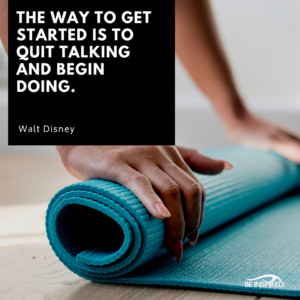Books. Newspapers. Magazines. The discussion around habits keeps popping up. I decided to dive into another book on the topic, Atomic Habits: An Easy & Proven Way to Build Good Habits & Break Bad Ones by James Clear.
Usually, a book’s introduction is worth skipping, but here, you’ll find the reason for James’ journey, which started with a terrible freak accident. His description does make you groan a little. He shares how a teammate had unintentionally let go of a baseball bat, which turned into a missile, smacking him in the head. It’s amazing that James lived.
Jumping forward in the introduction, you hear how habits became a key part of his growth. He writes that little habits helped him work through the accident’s long-term aftermath … especially during college.
“A habit is a routine or behavior that is performed regularly—and, in many cases, automatically. As each semester passed, I accumulated small but consistent habits that ultimately led to results that were unimaginable to me when I started.” 
So, why is everyone talking about habits? Habits are powerful. They can empower you and me to progress or even regress.
In a summary of a study on habits and health, the US National Library of Medicine states that, “A growing literature demonstrates the relevance of habit-formation principles to health.”
The summary later states, “We suggest that professionals could consider providing habit-formation advice as a way to promote long-term behaviour … .”
Another way to say it—use habits to improve your health. So, shall we? Let’s talk habits by highlighting the two-minute concept from James Clear.
Pick a Goal. Build a Habit to Get You There!
You might be getting ready for an overseas trip that requires lots of walking. Maybe you’re planning to attend your class reunion. Or, you’d like to keep up with the grandkids this summer.
To get ready, you pick a goal of walking three or four times a week for 30 minutes. Instead of mustering up the willpower to throw yourself in—which we’ve all experienced how this approach usually doesn’t work—use the two-minute rule. As an example, let’s outline what you might do to reach this goal of walking three or four times per week.
 Break the goal into small steps for two minutes each:
Break the goal into small steps for two minutes each:
First Day:
- Lay out workout clothes and walking shoes the night before. Two minutes and done!
- Come home from work. Put on workout clothes and shoes. Set timer on phone/watch and walk for two minutes. Seriously, if all you have energy for that day … just walk two minutes. If you have more energy, walk a little longer, but the goal isn’t “getting that walk in.” The immediate goal is to build a habit through frequent practice. The frequency eventually leads to the long-term and larger goal of walking three or four times per week.
- Go back to the house. You’re done! Get on with your evening.
- Before bed, remember to layout the workout clothes and shoes again.
Second Day and On:
- Do the same routine all week. Then add the two more minutes to your walk time the next week.
The process might seem almost silly. Remember, it’s about doing the steps frequently. I’ll let James explain.
“People often think it’s weird to get hyped about reading one page or meditating for one minute or making one sales call. But the point is not to do one thing. The point is to master the habit of showing up. The truth is, a habit must be established before it can be improved. If you can’t learn the basic skill of showing up, then you have little hope of mastering the finer details. Instead of trying to engineer a perfect habit from the start, do the easy thing on a more consistent basis. You have to standardize before you can optimize.”
I recently worked with a client using this very process. We defined the goal and timeline. We outlined the steps for creating habits. How about you? Would you benefit from someone helping you outline a habit-building plan? Give me a call or drop me an email.



![z31[1]](https://simplywholebydevi.com/wp-content/uploads/2018/06/z311-100x100.jpg)












